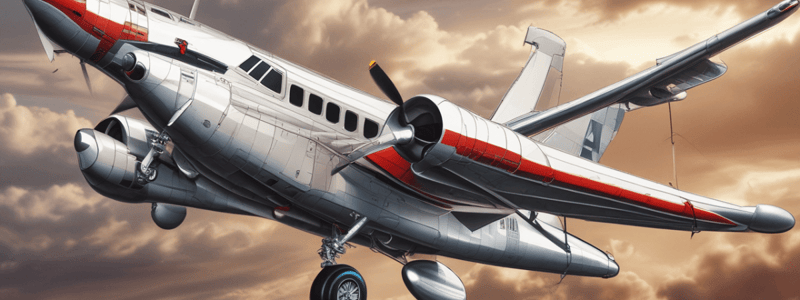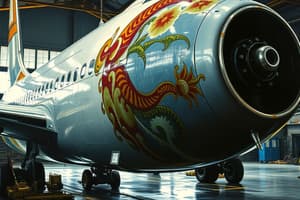Podcast
Questions and Answers
What is the primary reason for replacing copper tubing with aluminium-alloy and corrosion-resistant steel lines in aircraft?
What is the primary reason for replacing copper tubing with aluminium-alloy and corrosion-resistant steel lines in aircraft?
- Copper tubing was prone to becoming hard and brittle from flight vibrations (correct)
- Corrosion-resistant steel lines are more malleable than copper tubing
- Copper tubing was too expensive to maintain
- Aluminium tubing is lighter in weight than copper tubing
Which systems in aircraft typically utilize rigid tubing due to the requirement of long, relatively straight runs?
Which systems in aircraft typically utilize rigid tubing due to the requirement of long, relatively straight runs?
- Air conditioning systems
- Oxygen systems (correct)
- Avionics systems
- Hydraulic systems
In what pressure range are commercially pure aluminium tubing (1100-H14 or 3003-H14) commonly used in aircraft applications?
In what pressure range are commercially pure aluminium tubing (1100-H14 or 3003-H14) commonly used in aircraft applications?
- Above 3000 psi
- Below 500 psi (correct)
- Around 5000 psi
- 1000-2000 psi
How are aluminium-alloy tubes typically identified on larger tubes?
How are aluminium-alloy tubes typically identified on larger tubes?
Why did copper tubing prove troublesome in early aircraft applications?
Why did copper tubing prove troublesome in early aircraft applications?
What is the typical width of the coloured bands used to identify aluminium-alloy tubes on small tubing in aircraft applications?
What is the typical width of the coloured bands used to identify aluminium-alloy tubes on small tubing in aircraft applications?
What is the external flare angle for AN fittings?
What is the external flare angle for AN fittings?
What color are AN steel fittings for identification purposes?
What color are AN steel fittings for identification purposes?
In what way are flareless fittings different from flared fittings?
In what way are flareless fittings different from flared fittings?
What material are AN flareless fittings made of?
What material are AN flareless fittings made of?
What is the color of AN aluminium fittings for identification purposes?
What is the color of AN aluminium fittings for identification purposes?
How many parts does an AN flareless fitting consist of?
How many parts does an AN flareless fitting consist of?
How can aluminium alloy fittings be visually identified?
How can aluminium alloy fittings be visually identified?
What does the letter-number code in steel fittings such as MS21900-4 signify?
What does the letter-number code in steel fittings such as MS21900-4 signify?
Which material is used to make fittings indicated by MS21900-8-D?
Which material is used to make fittings indicated by MS21900-8-D?
What feature makes flareless fittings suitable for high-pressure systems with heavy wall tubing?
What feature makes flareless fittings suitable for high-pressure systems with heavy wall tubing?
What does the prefix 'MS' in fittings like MS21900-4 stand for?
What does the prefix 'MS' in fittings like MS21900-4 stand for?
What is the significance of '4' in MS21900-4 fittings?
What is the significance of '4' in MS21900-4 fittings?
What is the purpose of pre-setting when installing a new flareless tube assembly?
What is the purpose of pre-setting when installing a new flareless tube assembly?
What is the main function of universal bulkhead fittings?
What is the main function of universal bulkhead fittings?
How do tapered pipe thread fittings create a seal?
How do tapered pipe thread fittings create a seal?
What is NOT necessary when using bulkhead fittings for fluid lines?
What is NOT necessary when using bulkhead fittings for fluid lines?
Which type of fitting eliminates the need to flare the tube before installation?
Which type of fitting eliminates the need to flare the tube before installation?
What happens during pre-setting in relation to the sleeve and the tube?
What happens during pre-setting in relation to the sleeve and the tube?
Why is the design of the reinforcement layers in a hose critical?
Why is the design of the reinforcement layers in a hose critical?
What is the purpose of the outer cover on a hose?
What is the purpose of the outer cover on a hose?
How is an outer cover in areas of high heat different from a standard outer cover?
How is an outer cover in areas of high heat different from a standard outer cover?
What information can be found on the lay line of the outer cover of an aircraft flexible hose?
What information can be found on the lay line of the outer cover of an aircraft flexible hose?
How does the lay line on the outer cover help identify if a hose is installed properly?
How does the lay line on the outer cover help identify if a hose is installed properly?
Why is it important that the lay line shows if a hose is twisted when installed?
Why is it important that the lay line shows if a hose is twisted when installed?
Flashcards are hidden until you start studying
Study Notes
Flareless Fittings
- MS type fittings are commonly used in large transport category aircraft due to their ability to withstand high system working pressures (up to 8000 psi)
- Flareless fittings are made of aluminum alloy or steel
- Aluminum alloy fittings can be identified visually by their yellow color, which is caused by the anodizing treatment
- Cadmium plating on steel fittings is identified by letter-number codes (e.g., MS21900-4)
- MS number indicates the design part number, size of the fitting, and material (e.g., carbon steel, aluminum alloy, or corrosion-resistant steel)
Rigid Lines
- Rigid lines are used in stationary applications and where long, relatively straight runs are possible
- Systems that typically utilize rigid tubing include fuel, oil, oxygen, and instrument systems
- Aluminum-alloy and corrosion-resistant steel lines have replaced copper in most applications
- Aluminum tubing comes in various alloys (e.g., 1100-H14, 3003-H14) for low-pressure systems
Tube Identification
- Aluminum-alloy tubes are identified by alloy designation stamped on the tube's surface or by colored bands on small tubing
- Colored bands are no more than 4 in. wide and are painted on the tube's ends and mid-section
Flared-tube Fittings
- Flared-tube fittings are made of aluminum alloy, steel, or copper base alloys
- AN steel fittings are colored black, and AN aluminum fittings are colored blue
- AN 819 aluminum bronze sleeves are cadmium plated and not colored
- AN fittings come in various shapes and sizes, each with a specific use
Flareless Tube Fittings
- Two types of tube fittings are used on modern aircraft: flared and flareless
- AN fittings have a 37° external flare, while flareless fittings have an internal bevel of 24°
- Flareless fittings eliminate the need to flare the tube, but pre-setting is necessary prior to installation
- Pre-setting involves applying pressure to the sleeve to cause it to cut into the outside of the tube
Heavy Wall Flareless Fittings
- Heavy wall flareless fittings are used in high-pressure systems
Universal Bulkhead Fittings
- Universal bulkhead fittings are used to support lines that pass through a bulkhead
- Bulkhead fittings have straight machine threads and require flared tube connections, crush washers, or synthetic seals to make connections fluid-tight
Tapered Pipe Thread Fittings
- Tapered pipe thread fittings create a seal by wedging the tapered external male thread and the tapered internal female threads
- These threads taper 1/16 in. to the inch
Hose Construction
- Common reinforcement layers are made of cotton, rayon, polyester fabric, carbon-steel wire, or a stainless steel wire braid
- The outer cover is usually made of rubber-impregnated fabric or stainless steel braid and protects the hose from physical damage
- The outer cover is marked with a lay line, which consists of a yellow, red, or white stripe running the length of the hose
Studying That Suits You
Use AI to generate personalized quizzes and flashcards to suit your learning preferences.




